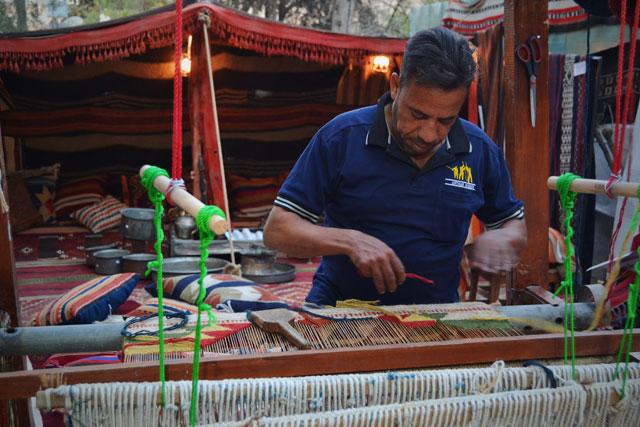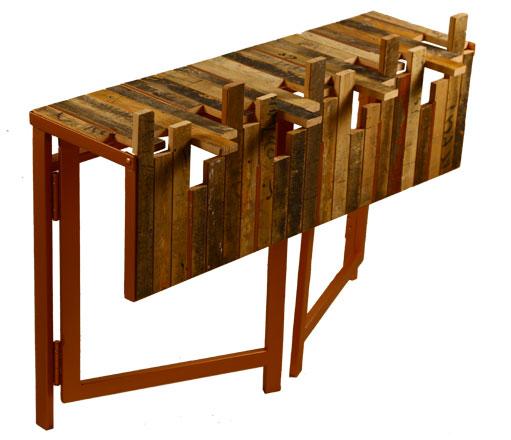You are here
Collector on a mission to keep bedouin art of weaving alive
By Saeb Rawashdeh - Jan 24,2015 - Last updated at Jan 24,2015

AMMAN — Fascinated by the paradoxical simplicity and complexity of traditional bedouin weaving, one Jordanian art collector has taken it upon himself to preserve the dying art.
Khalil Naouri, a self-made expert in traditional bedouin weaving, believes that weaving is slowly dying out in Jordan.
“When I decided to write a book on traditional Jordanian weaving I faced lots of obstacles. There was not much evidence about bedouin crafts in Jordan,” he said.
In 2013, Naouri completed his book “Hands and hearts” about traditional Jordanian bedouin weaving.
“It took four years of extensive research in collaboration with ethnologists and historians.”
“My goal was to document pieces of old Jordanian rugs before they were archived at the museum,” the author added, noting that “the book I created with some of my friends gave me the energy and the power to go on with my mission.”
He maintains that the bedouin art deserves appreciation and acknowledgement, not only from scholars but from the wider public and the world.
Naouri said he developed a passion for traditional bedouin art when he travelled to Iran, Turkey and Syria and conversed with dealers who initiated him in the secrets of the forgotten craft.
“I fell in love at first sight with the traditional colour, simplicity and story behind each piece. It is almost impossible to imagine such a manmade sophistication and complexity in the middle of nowhere.”
He collected carpets, tapestries, kilims, rugs, pillow covers and bags made of sheeps’ wool, camel pile and goat hair.
From a simple buyer Naouri transformed himself into a salesman and antique connoisseur; he would buy a few pieces and sell them, then purchase older and more precious works of art, advancing his knowledge about texture.
He has been particularly keen on works that date back decades.
“The purpose of buying such pieces was not to sell them to potential clients but to study the technique which was used for their weaving. When I saw nomad works from Iran eight years ago I focused on bedouin pieces from Bilad Al Sham [the Levant],” Naouri explained.
“As a rug dealer searching for inventory, I progressed to realising more about our regional weaving, and to gain a clearer picture my collection grew to over 1,000 pieces, of which 150 pieces that represent approximately 23 Jordanian tribes were selected [for the book].”
“There was not much interest in my work, nor any feedback from the established institutions,” noted Naouri, who has a shop showcasing traditional products, carpets and custom-made furniture near Mecca Street.
“The fact is that expatriates are more proactive than many local groups and institutions that only formally care about Jordanian heritage. We have many groups which are supposed to preserve our culture, but unfortunately, they lack the vision and a more proactive approach,” he claimed.
At present, Naouri seeks to create a local NGO that works to establish centres in the countryside in order to empower local bedouin women to preserve the old art of weaving and become financially independent by selling their work.
“The aim is to be as self-sufficient as possible by using local materials for the production of their work, using the same old methods in creating masterpieces. Hopefully we can establish [a] museum and research centres to be able to share the stories behind the weavings.”
“The emphasis should be on the integration of our national heritage in its contemporary form. Each piece should have a documented story related to it and my goal is to be able to preserve the pieces I collected in a museum, collect more stories and documentation for a second book and share our rich heritage with the world and its scholars,” Naouri added. “For me the past and the future, the modern times and tradition, are connected by a tiny thread of goat hair. Let’s not cut off the thread and let’s not break away from our traditional folklore.”
Related Articles
“Jordanian weaving is the work of artists. It is something to be fully experienced. You must see it, touch it, feel it and live with it. These pieces are so beautiful it is sometimes hard to imagine they were made for hard use.”
AMMAN — Audience get the chance to witness the traditional weaving techniques performed by different bedouin tribes at the “Woven — The art
AMMAN — For young Jordanian architect and designer Basel Naouri, Amman Design Week (ADW) is a great opportunity to display three pieces of h



















